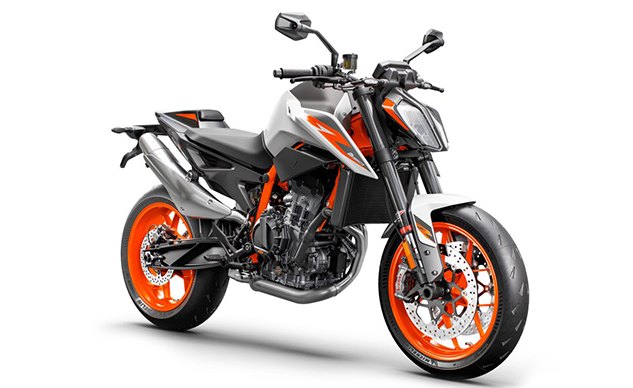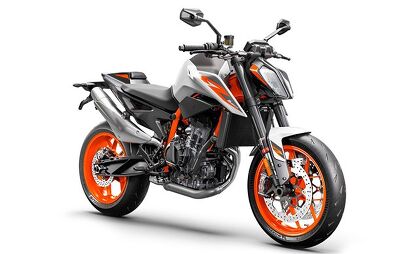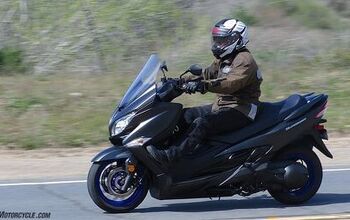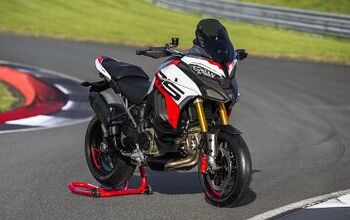6 Things You Need To Know About The 2020 KTM 890 Duke R

Get to know KTM's new Super Scalpel
By all accounts, the KTM 790 Duke is a great little motorcycle. Light, nimble, and with a healthy amount of middleweight power, when MO was given a 790 Duke to test, it was so much fun our own Evans Brasfield bought the damn press bike. He then proceeded to turn the bike into his version of what a 790 Duke R should be (you can read about his exploits elsewhere on this site). Little did he know KTM was doing the same halfway across the globe in Austria.
The results couldn’t be more different. While Evans raided the KTM Power Parts catalog to tastefully upgrade his 790, KTM basically threw the script out the window and adopted the wholly American ethos of there being no replacement for displacement. What it came up with is this, the 890 Duke R.
KTM’s “Super Scalpel” (as opposed to just “The Scalpel” for the 790) is “KTM’s expression of the most extreme naked bike in the midweight segment” with the biggest difference being the bigger engine. But there’s more to the 890 Duke R than just the engine, so let’s take a deeper dive into all the changes. Here, then, are Six Things You Need To Know About The 2020 KTM 890 Duke R.
Potent Parallel-Twin
Sure there may be more to this bike than the engine, but the 890 Twin is pretty important and has gone through significant changes. Based on the 799cc parallel-Twin from the 790, bore has gone up from 88 mm to 90.7 mm, stroke has lengthened from 65.7 mm to 68.8 mm, and compression ratio increases from 12.7:1 to 13.5:1. Both intake and exhaust valves increase in size one millimeter (36 mm to 37 mm on the intake side, 29 mm to 30 mm on the exhaust), camshafts have a more aggressive profile with more lift and longer duration.
Moving deeper into the engine, there are new connecting rods and new forged box pistons with three rings and shorter pins. Surprisingly, the pistons are lighter than before despite the bigger size and carry a higher rev limit compared to the 790. Because of these higher revs, a new balance shaft helps keep vibrations under control.
Speaking of keeping things under control, the crankshaft now has 20% more rotational mass (read, is heavier). While in some circles heavier is a negative thing, this isn’t necessarily the case with crankshafts as more rotational weight means the engine isn’t as abrupt or jumpy, giving the rider more control especially at part or neutral throttle.
Ride-by-wire throttle remains on the 890 Duke R, as do the 46 mm throttle bodies. But the real interesting thing here is the collaboration with Dell’Orto to utilize sensors in each cylinder to analyze manifold pressure and adjust the air/fuel ratio for each cylinder independently. According to KTM, the new engine pumps out 121 hp and 73 lb-ft (99 nm) of torque.
On the transmission side, lighter springs and shorter lever travel means faster, easier shifting. Software within the optional Quickshifter+ has been tweaked also, resulting in smoother shifting up or down, without the clutch.
Next Generation Electronics
The 790 Duke already had an impressive electronics suite, but of course, KTM saw fit to upgrade the 890 R. A new 6D lean angle sensor (otherwise known as an IMU) helps aid in the Cornering ABS and Cornering MTC (Motorcycle Traction Control), the latter benefitting from the 6D’s ability to better understand the bike’s position in a drift situation. Cornering MTC also benefits from new programming and two independent sensors, a wheelslip controller and pitch angle controller, for better acceleration and more precise wheelie control. And for those who don’t like electronics limiting their drive or wheelies, all this can be turned off.
Rain, Street, and Sport are the standard ride modes, with an optional Track setting also available. Track setting lets the rider customize their traction control, wheelie, and throttle control settings. Motor Slip Regulation (MSR) is another optional feature that acts as an electronic slipper clutch, ideal for low-grip situations.
Upgraded Suspension
With more power comes the need to harness it, and the 790 Duke’s steel chassis only needed small tweaks to accommodate. Ride height goes up 15 mm, which also raises the swingarm angle for better anti-squat behavior, ultimately providing better drive and stability out of corners. Of course, higher ride height means higher seat height (32.8 in vs. 32.5 in).
While entirely decent, most, including KTM, would agree the 790’s biggest weak spot was its suspension. For the 890, WP is providing its higher-spec Apex suspension with fully-adjustable fork and shock, the latter also getting high- and low-speed compression damping adjustability. The Apex fork splits compression and rebound damping between the two fork legs and comes equipped with linear rate springs. KTM/WP even leaves an Easter egg for Duke R riders: a list of suggested settings stored under the seat. (For those who followed Evans’ upgrades to his 790, this level of Apex suspension, according to our contact at KTM, slots between the 790’s non-adjustable suspension and the WP Apex Pro suspension that Evans installed.)
MO Tested: WP Apex Pro 6500 Cartridges And 6746 Shock For KTM 790 Duke
All The Brakes
Evans has gone through quite a bit of effort to upgrade the brakes on his 790, which is too bad because all he had to do was wait for the 890. The R gets Brembo components over J.Juan, including 320mm floating discs compared to the 300 mm on the 790. Aluminum carriers shave off almost a full pound – per disc!
MO Tested: KTM PowerParts Wave Brake Discs
MO Tested: Brembo 19 RCS Corsa Corta Master Cylinder
Calipers get upgraded to Brembo Stylema units that optimize airflow into the caliper itself to help cool the pads and use less fluid. This combined with the Brembo MCS (Multi Click System) master cylinder, which provides an adjustable lever ratio, means you can have progressive feel at the lever or a nearly instantaneous reaction. When it’s all added up, the new brake system alone shaves 2.6 lbs of unsprung weight compared to the 790.
Ready-To-Race Ergonomics
Typically, the point of naked bikes is not to place the rider in a super-aggro sportbike position, with handlebars placed high and footpegs low. KTM has thrown that recipe out the window. The 890 Duke R, like all KTMs, embodies the Ready-To-Race ethos. New, flatter tapered bars are lower, further forward, and adjustable in four positions on the triple clamp. They can be further rotated three more positions from there. Footpegs, too, are new, higher and more rearward, though the pegs themselves are larger for more surface area.
Price
If all of the above didn’t get you excited about the 890 Duke R already, then maybe this will. KTM’s asking price is $11,699 USD – just a thousand bucks more than the 790. Having spent considerable time with the 790, we thought it was a good value at the time. Now, with the 890’s increased performance, we have no reason to believe it won’t be an even better value. Of course, all we have left to do now is ride it to see if our suspicions are correct. Once all this Coronavirus stuff is over and we can get a bike in our hands, we intend to find out. Who knows; if it goes well you might see Evans’ 790 go up for sale. Ha!

Troy's been riding motorcycles and writing about them since 2006, getting his start at Rider Magazine. From there, he moved to Sport Rider Magazine before finally landing at Motorcycle.com in 2011. A lifelong gearhead who didn't fully immerse himself in motorcycles until his teenage years, Troy's interests have always been in technology, performance, and going fast. Naturally, racing was the perfect avenue to combine all three. Troy has been racing nearly as long as he's been riding and has competed at the AMA national level. He's also won multiple club races throughout the country, culminating in a Utah Sport Bike Association championship in 2011. He has been invited as a guest instructor for the Yamaha Champions Riding School, and when he's not out riding, he's either wrenching on bikes or watching MotoGP.
More by Troy Siahaan






























































Comments
Join the conversation
Great looking bike. Would love to add that to my stable.
Wait a sec, did a reputable magazine just question if linear rate springs are progressive??? 🤦🏽♂️